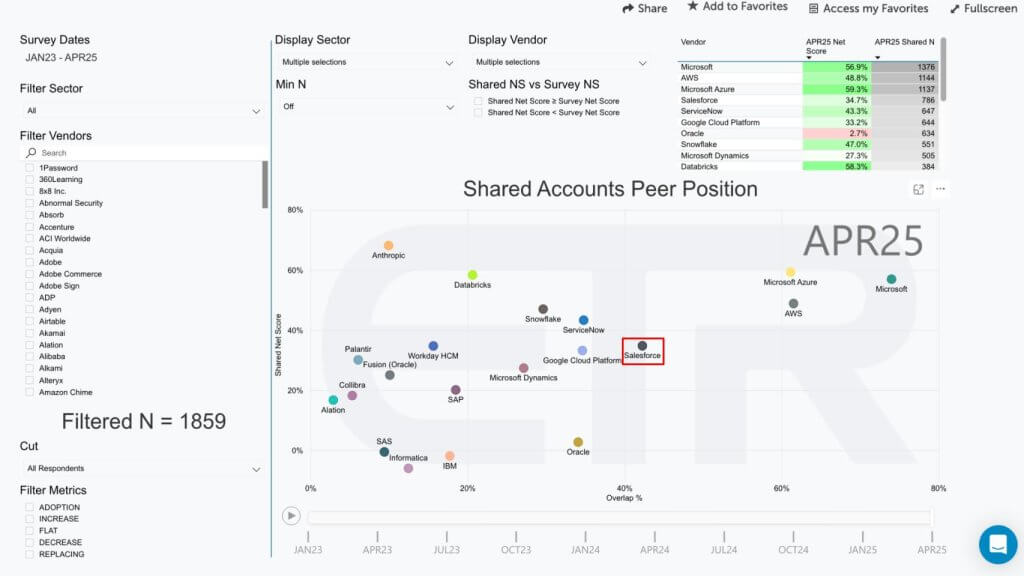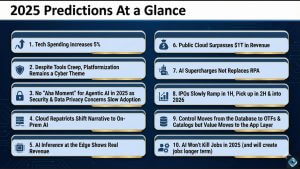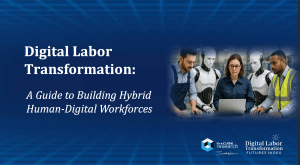The Road to ‘Service-as-Software.’ Salesforce co-founder and CEO Marc Benioff is articulating a bold vision for the next era of enterprise software. In an exclusive interview with theCUBE on April 25, 2025, Benioff outlined how AI-driven agents and a unified data architecture will transform Software as a Service (SaaS) into what we’re calling “Service as Software” – a model where software-based digital agents augment every business process. The Salesforce chief has often quipped that today’s CEOs are “the last generation of executives leading exclusively human workforces,” underscoring his conviction that AI agents (what many call agentic AI) will soon work alongside humans in every enterprise. Our premise is that this “digital labor” revolution could be more disruptive than the cloud and mobile waves of 15 years ago, fundamentally redefining how applications function.
In this Breaking Analysis, we focus on Salesforce’s Agentforce and Data Cloud strategies – the twin pillars of its agentic vision – and how they position the company to become what we call the first software-only hyperscaler. We also examine the broader industry context, including competitive dynamics with Microsoft and Salesforce’s interoperability with platforms like Snowflake, Databricks and AWS.
Agentforce: AI Agents Ushering in the Service-as-Software Era
Agentforce is Salesforce’s new platform for AI-driven enterprise agents – autonomous or semi-autonomous software assistants embedded across its applications. Benioff is clearly energized by the potential of these agents as he explained to us and in several podcasts in the last 6-9 months: “I’ve never been more excited in my job than since I started Salesforce… it feels like a startup.” The goal is not a mere chatbot, but rather an agentic layer tightly integrated with business data and workflows to amplify human productivity. According to Benioff, Salesforce internally is already aggressively rolling out Agentforce: “our employees who are using Agentforce – and I have tens of thousands of them right now – they don’t have access to data now that they didn’t before… the data is still governed through the sharing model,” Benioff explained. In other words, these AI agents can act on Salesforce’s behalf, but within the same access controls and governance as human users. We believe this illustrates Salesforce’s pragmatic approach – layering AI agents on top of (not in place of) existing software roles, thereby driving immediate productivity gains without breaking data policies.
Benioff’s vision for Agentforce is ambitious: He’s claiming 50% productivity increases across engineering, services, and support functions by infusing these “agentic” capabilities into workflows. That’s up from claims of 30% just a few months ago. Such gains, if compounded over several years, would be transformative. Indeed, early customer deployments hint at what’s possible. For example, according to Salesforce, Disney is using Salesforce’s AI agents to enhance theme park operations. Benioff, says Disney now has “agent fluidity,” where thousands of AI agents for park attendees can simultaneously tap into customer preferences, ride availability, and other systems to recommend personalized experiences – something that human staff would struggle to coordinate in real time. This concept of agent fluidity – i.e. AI agents moving easily across datasets and applications – is an early example of Service-as-Software in action. Our research indicates that Agentforce, by leveraging all of Salesforce’s rich customer context (i.e. technical and operational metadata, business logic and workflow knowledge), can unlock new levels of automation and personalization that simply were “not possible a couple of years ago.
Company statements indicate that Salesforce’s first cohort of AI-driven agents, launched in mid-2024 to automate high-volume service tasks, gained strong traction almost immediately. In a matter of months the company claims to have enrolled more than 5,000 organizations—about 3,000 on paid tiers—demonstrating that Agentforce has revenue traction. The Data Cloud & AI portfolio that houses Agentforce approached $1B in annualized run-rate revenue for FY 2025.
Early success is creating a flywheel effect across the broader Salesforce. New AI capabilities are supporting demand for the major Salesforce clouds; internally, management points to a measurable “halo effect” that is driving upgrades and cross-cloud expansions. Research shows dozens of seven-figure AI transactions closed recently, suggesting that Agentforce acts as a value unlock on both wallet share and customer stickiness.
Importantly, in our view, the strategy augments rather than dilutes Salesforce’s existing application suite. Instead of betting on a single, free-floating general AI, Salesforce is embedding domain-specific agents directly into its platform, where unified data, metadata and workflow logic are already in place. This approach eliminates the costly do-it-yourself integration projects that only the most technically sophisticated enterprises can pursue. The company is also laying the groundwork for a marketplace in which customers and partners can publish specialized agents, a move that would extend network effects and further entrench Salesforce at the center of enterprise workflows.
Data Cloud: The 4D Data Engine Behind Salesforce’s AI Ambitions
Underpinning Agentforce, and in our view fundamental to Salesforce’s strategy, is the Salesforce Data Cloud. Simply put, Data Cloud is Salesforce’s unified real-time data platform. It aggregates and harmonizes data from both Salesforce applications and external sources into what Benioff calls a “rich 4D map of the state of the business.” This is a foundational shift in Salesforce’s architecture. Specifically, instead of each app siloing its data, Data Cloud serves as a single source of truth and context across all Salesforce services. Conversations we’ve had with Salesforce’s key engineering and product leaders indicate that Salesforce has been rewriting core applications (Sales Cloud, Service Cloud, Tableau, etc.) to deeply integrate with its Data Cloud. A prime example is Tableau, the analytics platform Salesforce acquired in 2019. Benioff revealed that “Tableau now has a semantic layer… a data layer… an action layer… [and] a metadata layer. And it is an embeddable application in our core apps in Slack. So that very much starts to set up the framework for the future.” In other words, Tableau was rebuilt on Data Cloud and can now natively appear within other Salesforce apps (e.g. you can see a Tableau visualization right inside Slack or Sales Cloud). This kind of embedded analytics and cross-application data sharing is exactly what Data Cloud is meant to enable. We believe such deep integration is critical for AI agents to be effective – the agents need unified, real-time data and a common metadata framework to operate intelligently across different business functions.
Salesforce Data Cloud is not only designed to break down data silos; it also connects to external data ecosystems. Benioff emphasizes “data fluidity,” describing how Salesforce can federate data across other platforms and applications without necessarily forcing all data into Salesforce’s own storage layer. Through strategic partnerships, Salesforce has made major third-party data platforms essentially extensions of its Data Cloud. For instance, Salesforce has built bidirectional “zero copy” data sharing with Snowflake, the popular cloud data warehouse. This allows Salesforce Data Cloud to query data in Snowflake on the fly (and vice versa). Ironically, Salesforce’s use of the term “Data Cloud” echos the term first used by Snowflake.
Salesforce touts a similar partnership with Databricks to bring Lakehouse data into the fold, where customers can merge Databricks’ lake data with Salesforce Data Cloud, and even bring their own AI models from Databricks into Agentforce. The data suggests Salesforce is embracing an open integration strategy: rather than treating Snowflake or Databricks as competitors, it’s interoperating with them to enrich Salesforce’s 360° customer view.
AWS is another key partner, Salesforce’s Hyperforce infrastructure initiative allows its software to run on AWS (and other public clouds) globally, and Salesforce is working closely with AWS on integrations (for example, connecting Salesforce’s platform with AWS AI services and data lakes). We believe this openness is a smart move that extends Salesforce’s reach and sets up our premise that Salesforce is angling to become the next (software-only) hyperscaler. The strategy is enabled by allowing Salesforce’s AI agents to see data beyond Salesforce’s native apps, tapping into external data lakes or warehouses as needed. As Benioff noted, once data is unified (or federated) through Data Cloud, it benefits from network effects, again ironically emphasized by Snowflake CEO Frank Slootman in his book Rise of the Data Cloud. For customers, this means information previously trapped in, say, an ERP database or a marketing data lake can now directly inform an AI-driven sales or service agent in Salesforce.
That is a powerful value proposition. Importantly, Salesforce’s Data Cloud strategy also underscores trust and governance. In the interview, Benioff repeatedly stressed that governance does not disappear in the agent era. “Data has to be managed a certain way. That doesn’t go away with agents. It doesn’t go away with AI,” he told us. Salesforce is leveraging its heritage in enterprise security (e.g. granular sharing models, metadata-driven access controls) to ensure that even as data flows freely, it remainsgoverned.
When Microsoft’s CEO Satya Nadella suggested that dedicated SaaS applications might fade away – that future AI agents could just interface directly with raw CRUD (create, read, update, delete) databases, Benioff strongly disagreed. He dismissed that notion as impractical, arguing that “just dumping all your data… into some big repository and then letting all your employees jostle through that data” would cause serious issues. We agree that a deterministic software layer is needed to mediate access, enforce permissions, and provide a semantic understanding of the data for the agents. At the same time there is some validity in Nadella’s notion that an agentic layer increasingly will be relied upon to manage data and simplify access for users. In Salesforce’s model, Data Cloud is that layer as it unifies data but also tags it with metadata, definitions, and policies. Our research indicates this approach will initially resonate with enterprise customers who must balance innovation with compliance. Simply letting a generative AI loose on ungoverned data (as one could infer from Nadella’s scenario) could turn into a compliance nightmare. But over time, as AI improves, Nadella’s scenario could gain traction for certain environments.
Becoming a ‘Software-Only’ Hyperscaler
A key thesis of our research is that Salesforce is advancing its ambition to become the first software-only hyperscaler. Traditional hyperscalers like AWS, Microsoft Azure and Google Cloud, achieve scale by pouring tens of billions of dollars into data-center infrastructure. Salesforce is pursuing the same reach and influence through pure software and SaaS platforms, sidestepping the capital intensity of owning physical compute. With Hyperforce, the company can deploy its stack on public clouds worldwide, acting as a “supercloud,” abstracting the underlying complexities and primitives from each cloud and delivering global coverage and multi-tenancy while retaining the investment profile of a software firm. the downside is a major part of its COGS comprises cloud costs (i.e. the thesis laid out in the Trillion Dollar Paradox by Sarah Wang and Martin Casado). We believe these costs can be managed effectively through negotiations for long term volume agreements with cloud players and is in many ways a more attractive model for Salesforce.
This fiscal year Salesforce will generate roughly $50 billion in revenue and show healthy free cash flow, even as the big three cloud providers plus Meta collectively spend more than $300B on CapEx. In other words, we believe hyperscale economics can be replicated without hyperscale-level hardware investments.
The playbook hinges on elevating Data Cloud and Agentforce as the value layer that rides atop commodity infrastructure. Data, and the intelligence extracted from it, becomes the Salesforce moat, not server, storage and networking excellence. By weaving agents, workflows, and federated datasets directly into customers’ day-to-day processes, Salesforce is attempting to position itself as the neutral orchestration tier across heterogeneous environments. This interoperability strategy, extending to Snowflake, Databricks, AWS, and even competitive realms such as Microsoft 365, turns Salesforce into the connective tissue of the enterprise cloud stack. In effect, the company seeks to function as the software brain that unifies disparate systems while leaving the heavy lifting of data-center operations to others.
Executing on this vision requires investment, and Salesforce appears to be leaning in. The company reversed last year’s belt-tightening by adding roughly 2,000 sales and engineering roles to accelerate its AI and Agentforce agenda. Management has begun providing some guidance on Data Cloud & AI as a standalone line item, underscoring its strategic weight. Annualized revenue for that segment will continue to grow rapidly in our view and leadership is signaling a path to multibillion-dollar scale. If successful, Salesforce will deliver hyperscale-level services entirely through subscription software and usage-based licensing—rewriting the rules of cloud economics and redefining what it means to be a hyperscaler in the AI era.
Competitive and Industry Context: Microsoft, SaaS Firms, AI Ecosystems, and the Race to Services as Software
The rush to embed generative AI agents into enterprise software has become the industry’s new arms race. Scores of existing SaaS firms, cloud companies, AI leaders and startups are all debuting their own digital assistants—yet none looms larger for Salesforce than Microsoft. A long-standing rivalry that began in CRM and collaboration is now manifesting in AI platforms, with Microsoft promoting a closed, vertically integrated approach rooted in its Azure and Office stacks. By contrast, Salesforce appears to be positioning itself as the neutral, cross-cloud connective tissue, where Agentforce serves as an orchestration layer that taps any governed data source, preserving the business-application context that enterprises rely on. In concept, organizations that value transparency and robust metadata are likely to prefer this structured model over a black-box agent tethered to a single cloud vendor. But the industry is a moving target.
Below we show spending data from ETR’s latest survey of more than 1,800 IT decision makers. The vertical axis shows spending velocity of Net Score and the horizontal axis represents Overlap or penetration of each platform in the data set. We’ve cherry-picked a number of players either directly vying for industry dominance (e.g. Microsoft, Oracle, etc.), SaaS and governance players protecting their turf that will continue to innovate with AI and Salesforce itself (highlighted). The point of the data is its a crowded market with highly fragmented data silos. Busting those silos will not be trivial for Salesforce or any vendor.

Many key challenges remain for Salesforce, including: The maturity and quality of Salesforce’s technical stack; 2) The customer experience outside of the Salesforce software domain; 3) The willingness of customers to put their trust into the Salesforce platform; 4) The innovation and quality of alternatives – e.g. Palantir, ServiceNow, Workday, SAP, Oracle, Microsoft, Google, AWS, etc. (building similar capabilities within their respective domains); 5) Emerging horizontal integration alternatives like IBM, UiPath, Celonis (currently in a fight with SAP over data access); and 6) Pricing. Salesforce’s seat-based pricing model has never been perceived as customer-friendly and pricing for agentic AI is still in its infancy – miscalculations could bring customer backlash.
Another competitive front centers on data infrastructure. Snowflake, Databricks, Google and AWS are all vying to become the canonical system of record for enterprise data lakes and warehouses. Rather than fight these platforms for raw storage, Salesforce has opted to integrate with them. According to Salesforce, Data Cloud can read and write directly to external lakehouses, then surface curated slices inside Salesforce apps where Agentforce can act on them. This strategy neutralizes customer concerns about data duplication, positions Salesforce as a first-class participant in modern data architecture, and underscores the company’s conviction that no single vendor will own all enterprise data in the AI era. Integrators that interoperate best and avoid locking in customers will capture the greatest value in our view. At the same time, firms must be cognizant of creating new moats.
Finally, what we see as Salesforce’s Service-as-Software push is notable for its architectural depth. While many vendors are bolting chatbots onto legacy products, from our research, led by George Gilbert, we see Salesforce re-plumbing its stack – i.e. data, metadata, UI, and workflows – to be natively AI-powered. That cohesiveness could be a real differentiator, but it comes with execution risk. Operating as a software-only hyperscaler requires tight collaboration with public-cloud partners, careful cost management as usage scales, and demonstrable ROI for customers. Early evidence, with multiple seven-figure AI transactions and seemingly robust Agentforce adoption, suggests the value proposition is resonating. Still, Salesforce must continue to prove that its federated, platform-centric approach can outpace both closed ecosystems and upstart specialists as AI agents move from hype to everyday enterprise reality.
Will Salesforce Win the Race to AI-Native Scale?
As you know, we love founder-led companies as we believe such organizations have unique advantages, particularly around sense of urgency. Salesforce is moving with the urgency of a company intent on shaping the next decade of enterprise technology. By launching Agentforce and Data Cloud, it has staked out a vision of what we call “Service-as-Software,” positioning itself as the platform that will create and govern tomorrow’s digital workforce. Early signals are encouraging as customer adoption appears brisk, ARR from AI-driven products is expanding rapidly, and the technology is already tightly woven into Salesforce’s core apps. Still, the contest is just beginning. Microsoft’s deep pockets and pervasive reach, alongside a swarm of SaaS rivals and AI-native startups, ensure stiff competition. Even so, Salesforce’s blend of scale, data-rich applications, founder vision and open-federation strategy gives it a meaningful chance of success. Should execution stay on track, the company could hit a singular milestone – i.e. delivering hyperscale value purely through software, without owning its own hardware footprint.
The next twelve to twenty-four months will serve as a pivotal proving ground. Internally, Salesforce is targeting 50-plus percent productivity gains from agents; externally, it is pushing to embed AI across its entire customer base and drive its Data Cloud & AI run-rate into the multibillion-dollar range. Competitive intensity will only rise as every vendor fine-tunes its agent strategy, yet Salesforce benefits from a clear, CEO-driven blueprint. Momentum is already substantial, large AI deals are closing, customers are seeing tangible ROI, and the platform’s global reach continues to expand. If Salesforce sustains this trajectory, it could redefine what a cloud leader looks like by the late 2020s, cementing its place as the trusted enterprise AI platform while rewriting the economics of hyperscale for the software-only era.



